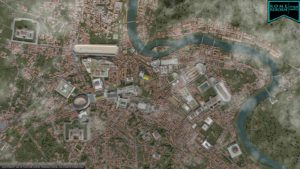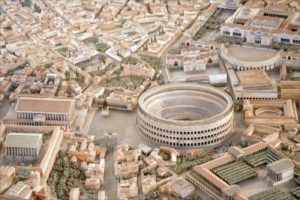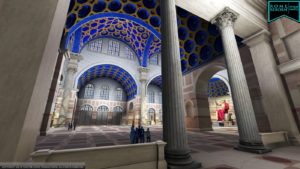A Virtual Reality App that Reconstructs Ancient Rome May Have Exploited Its Developers
 Ancient Rome wasn’t built in a day and neither was Rome Reborn. Since 1996, the Rome Reborn project has depended upon dozens of researchers to build sophisticated three dimensional models of antique structures that capture the dynamic architectural history of the Eternal City. Details such as painted (i.e. polychromatic) marbles and statues have been painstakingly inserted into the urban city plan. As a result, not only the structures, but also the vibrant color of the ancient world have been revivified. Helmed by project director and classicist Bernard Frischer, the ultimate goal of the project is to rebuild a shifting, interactive model of the city that extends from just before its mythical founding date in 753 BCE to the middle of the reign of the late Roman emperor Justinian around 550 CE, during the period of the Gothic Wars. Right now, viewers are limited to a bird’s eye flyover of the entire city, a tour of the Roman Forum, and a walk-through of the Basilica of Maxentius in the early 4th century CE.
Ancient Rome wasn’t built in a day and neither was Rome Reborn. Since 1996, the Rome Reborn project has depended upon dozens of researchers to build sophisticated three dimensional models of antique structures that capture the dynamic architectural history of the Eternal City. Details such as painted (i.e. polychromatic) marbles and statues have been painstakingly inserted into the urban city plan. As a result, not only the structures, but also the vibrant color of the ancient world have been revivified. Helmed by project director and classicist Bernard Frischer, the ultimate goal of the project is to rebuild a shifting, interactive model of the city that extends from just before its mythical founding date in 753 BCE to the middle of the reign of the late Roman emperor Justinian around 550 CE, during the period of the Gothic Wars. Right now, viewers are limited to a bird’s eye flyover of the entire city, a tour of the Roman Forum, and a walk-through of the Basilica of Maxentius in the early 4th century CE.

La maquette de Rome à l'époque de Constantin (306-337) réalisée par Italo Gismondi entre 1933 et 1937. Cette maquette de 200 m de long est présentée au musée de la civilisation romaine à l'EUR à Rome. Elle est à l'échelle 1/250.
Over two decades, the various versions of Rome Reborn have been developed by dozens of artists, classicists, archaeologists, and 3D modelers at numerous institutions. The virtual reality tour of the city started as a digital humanities project at the University of California at Los Angeles, where architectural historians like Diane Favro and 3D modelers such as Dean Abernathy contributed to its early development and later launch. Frischer then moved the project to the University of Virginia and then finally to Indiana University, while also developing a for-profit company that created games and media focused on ancient Rome.
Looking at the modest (but still not paltry) cost of the products connected to Rome Reborn, some digital humanists have questioned whether it is ethical to profit personally from a virtual project that has benefitted so mightily from the public investment in digital humanities and heritage preservation made over the last few decades. Although universities and funding agencies have developed mechanisms for allowing project directors to acquire the copyright to cultural heritage models, debates over this area of 3D modeling are still being waged. In comments to Hyperallergic, Ethan Gruber, now the Director of Data Science at the American Numismatics Society, noted his current unease with the project, which he previously worked on from 2007 to 2008, while at UVA:
As a staunch proponent of open data and open access to cultural heritage, I am disappointed to learn that the contributions made in good faith to promote the free and open proliferation knowledge have been commercialized. I am shocked that a project developed largely with taxpayer funding has been trademarked by a private company registered to Bernie Frischer himself.
In the future, Rome Reborn plans to expand into the area of the Colosseum and sell an interactive experience centered on the Roman Pantheon, as well as other well-known sites in Rome. The project is itself a testament to how far the field of digital cultural heritage has come and will no doubt spark interest anew in 3D interactions with the cities of the past. Yet for all the majesty that this virtual experience brings, the project and its products still pose questions about how we cite and credit those who have developed long-term digital heritage projects over the longue durée, who should profit from their sale, and whether such cultural heritage content should be more available to the public in an open-access repository.
See the full story here: https://hyperallergic.com/480239/a-virtual-reality-app-that-reconstructs-ancient-rome-may-have-exploited-its-developers/
Pages
- About Philip Lelyveld
- Mark and Addie Lelyveld Biographies
- Presentations and articles
- Tufts Alumni Bio
